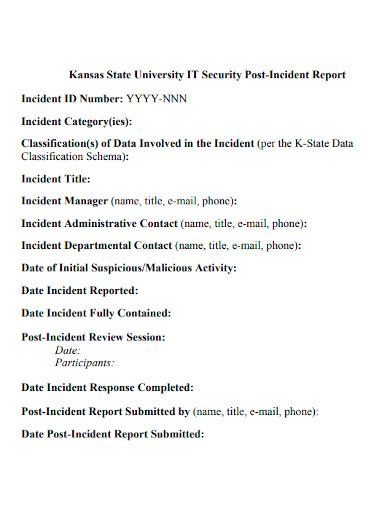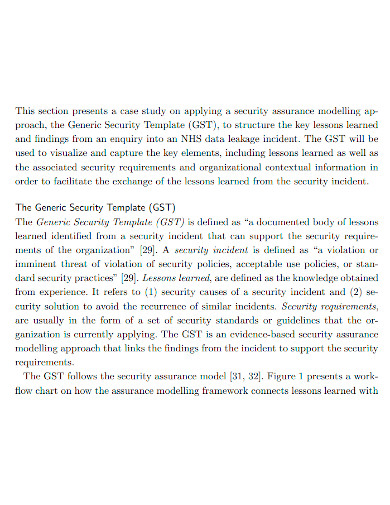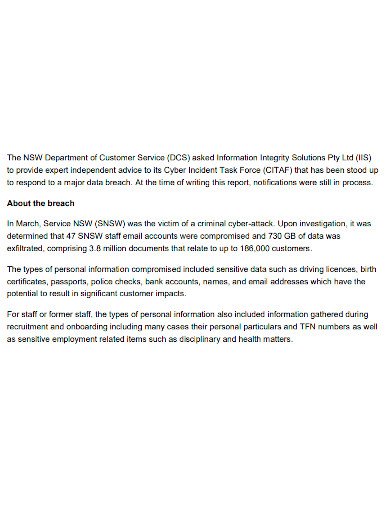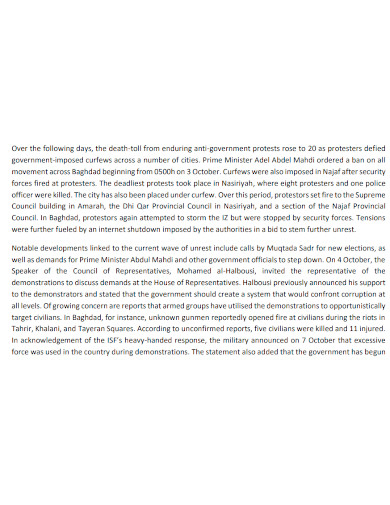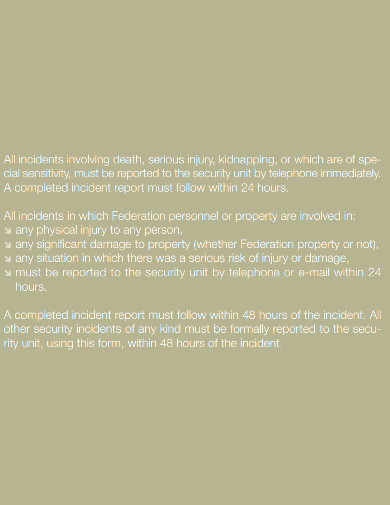Incident reporting typically involves completing an incident report form when an incident occurrence has happened and following it up with additional incident follow on forms such as an investigation, corrective action, hazard report and sign off. These follow on forms ensure that the incident occurrence causes are investigated to potentially mitigate and aim to prevent the same type of incident from happening again. This might involve discovering hazards in the workplace or implementing new risk management or training processes to help staff understand the root causes of what happened in order to prevent it from happening again. An Incident Report form might be completed by the staff involved in the incident that occurred or it might be completed by a safety manager on their behalf. See more on how to write an incident report.
5+ Post-Security Incident Report Samples
1. Post-Security Incident Report Sample
2. Printable Post-Security Incident Report
3. Editable Post-Security Incident Report
4. Standard Post-Security Incident Report
5. Formal Post-Security Incident Report
6. Post-Security Incident Report Format
What Are the Incidents That Needs to be Reported?
Incidents That Need to Be Reported
Four main types of incidents should be reported in an organization:
- Unexpected Event: These events include unexpected incidents or accidents that result in fatal, non-fatal physical injury, or serious psychological injury to workers.
- Near Misses: These events include incidents or accidents that had the potential to cause harm but did not do so.
- Adverse Events: These events are related to adverse reactions to medicine, vaccines, or medical devices used for treating a medical condition or situation.
- Awareness Events: This involves reporting any risks of potential incidents or accidents that can take place in the line of duty. The risks could be faulty or malfunctioning equipment, or the lack of safety equipment, training, and controls. The report must be communicated to all employees so that they can take the necessary steps to mitigate the risk.
How to Write a Post-Security Incident Report
1. Take Immediate Action
Employees of your organization should notify their manager or another member of the company’s leadership committee as soon as an incident occurs–regardless of the nature of the event (whether it be an accident, illness, injury or near miss).
That being said, there needs to be communication channels clearly defined to promote the practice of employees coming forward in these situations and the importance of such.
Once an incident has been reported, the member of leadership’s first responsibility is to ensure that appropriate treatment, if necessary, is being administered to those affected by the event.
If the hazard still exists, the manager that the event has been reported to must eliminate the hazard by controlling it. Each company should have a defined procedure for accomplishing this based on the nature of their work.
For example, if there was a spill that caused a fall. You would attend to the victim and promptly have the spill wiped up and identify the area as a hazard by using a sign.
2. Collect the Facts
Once the immediate action including the response to the event and eliminating the hazard from the environment has been conducted, it’s time to determine and record the facts related to the incident details.
Facts related to the incident include:
The Basics
Identify the specific location, time and date of the incident. This information is fundamental to the investigation and the most obvious information to collect.
The Affected
Collect details of those involved and/or affected by the incident. This would entail recording the name(s) of the individual(s) involved, their job title(s), the department(s) they operate in the manager(s) of those affected.
The Witnesses
Speak to any witnesses of the event to collect their perspective of the event. Record their statements as detailed and accurately as possible in the form.
To ensure accuracy, it’s best practice to review your notes with the witness to ensure they agree with how the event is portrayed on the report. It’s also important to include the name(s) of any witnesses in the report in case any additional questioning is required.
The Context
Consider and document the events that occurred leading up to the incident. Ask:
- What was the employee doing?
- Who asked them to complete the task? How was the employee feeling prior to the incident? …etc.
It is important to identify which factors were an outcome of the incident and which factors were present prior to the incident and could be a potential contributing factor to the incident occurring.
The Actions
In the report, you must specify the actions of those involved at the time of the incident. What did the employee do that led to the incident?
For example, if an employee injured their back when lifting a box at work, it is important to determine how that employee lifted the box to decide if that contributed to their injury. If yes, then inquire if this employee was trained properly for this task and by who or what source?
The Environment
Identify and record environmental conditions that contributed to the event. Was there inadequate lighting? Was a piece of equipment not operating properly? Was the employees visibility obstructed by a glare or blind spot? Etc.
The Injuries
Record detailed descriptions of specific injuries and evaluate the severity of such in the report. This description should include part(s) of body injured, nature and extent of injuries.
The Treatment
It is also important to document in the incident case report the type of treatment administered for the acknowledged injuries. This information is important to document in order to understand how the employee recovers when reviewing the specifics of the event.
The Damages
Record an account of any damage to equipment, materials, etc that was affected by the incident. This will be helpful to refer back during the analysis of the event in order to consider a both a corrective action plan and to determine what items will need to be repaired or replaced.
3. Analyze and Reflect
Collecting and recording the facts related to the occurrence of the incident will aid in determining how the incident occurred. Analyzing the collected facts related to the incident will aid in determining why the incident occurred.
Analyzing and determining how and why the incident occurred is essential in order to develop an effective corrective action plan.
Potential causes for accidents or injuries that occurred in the workplace could include:
- Primary causes (for example, an unsalted ice patch on a set of stairs that caused a slip and fall).
- Secondary causes (for example, an employee not wearing appropriate personal protective equipment, such as a hard helmet or eyewear).
- Other contributing causes (for example: a burned out light bulb in the area causing poor visibility).
4. Establish a Corrective Action Plan
A Corrective Action Plan would provide recommendations as a means to reduce the possibility of a continued issue and/or recurrence of the incident details. The recommendations would result from an effective analysis of the facts collected and documented in the incident report.
Elements of an effective Corrective Action Plan could include:
- Occupational Health & Safety training for employees
- Preventative routine maintenance processes that ensure equipment is in proper working condition
- A review of job practices and procedures with a recommendation for changes to reduce the risk of incidents
- Conducting a job hazard analysis to determine if other potential hazards are associated with the task and/or environment and then training employees on these hazards based on the findings of the assessment
- Engineering, equipment or PPE changes/upgrades to ensure the task or the process of completing said task poses less risk
FAQs
What are the details to include in an incident report?
- Type of incident
- The location of the incident including date and time
- Details of the injured person
- A list of witnesses to the incident or injury
- Detailed description and severity of the injury
- A description of the immediate measures taken in response to the incident
- Detailed description of the treatment after the incident
- Any anomalies that might have contributed to the incident
- Photo or video documentation of the event or its aftermath can also be included in an incident report
- Analysis of the incident
What are the four types of incident reports?
- Near Miss Reports
- Injury and Lost Time Incident Report
- Exposure Incident Report
- Sentinel Event Report
How do you handle emergency situations?
- Take a deep breath.
- Count to 10. Tell yourself you can handle the situation.
- Check for danger. Protect yourself and the injured person from fire, explosions, or other hazards.
- Try to look at the situation as a whole.

